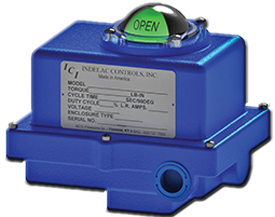Condensation + Electric Actuators = Issues

However, if I told you I had a friend call me this week and tell me that their climate has been very hot and dry for quite some time but they were experiencing a water problem with one of their electric actuators. He told me there was so much water in the electric actuator enclosure he literally had to pour the water out of his actuator.
Now that’s something you would probably have to give some serious thought to, right? Actually it is not a mystery or uncommon at all. It concerns something we are all familure with but give very little thought to in our day to day lives. I am talking about CONDENSATION.
Technically the amount of water vapor air can hold is directly related to the air temperature. Warmer air can hold more water vapor than cooler air. When warm air is cooled it loses its capacity to hold water vapor and will begin to condense forming water droplets (CONDENSATION) if cooled enough.
It is important to understand that relative humidity is not the measurement of the actual amount of water vapor in the air, but rather the amount of water vapor present compared to the maximum amount of water vapor the air can hold at that particular temperature and pressure.
For example:The air temperature in an electric actuator is 70° F. and it has an amount of water vapor that produces a relative humidity of 50%. As the ambient temperature decreases to 50° F. the amount of water vapor has not changed. This drop in temperature changes the relative humidity in the actuator to 100%. The air is now holding its maximum amount of water vapor for that temperature. It has the same amount of water vapor, but because of the lower temperature the relative humidity becomes greater. As the ambient temperature decreases the air becomes saturated and the water vapor condenses and condensation develops inside the electric actuator.
The real effect of temperature will be the relationship between the enclosure inside air temperature and the outside temperature. The colder the temperature outside the colder the enclosure surface temperature will become. As the enclosure surface cools down the air near the inner walls begins to cool as well. If this air cools below its maximum vapor saturation point condensation will begin to form in the actuator.
In my friends case what was happening is during the hot days the enclosure and air inside the actuator became hot. Then as the sun began to set the air outside the actuator cooled down, this decrease in ambient temperature caused the water vapor inside the enclosure to become saturated, condensed and condensation formed.
This is a real problem and can cause hundreds of dollars of damage to his electric actuator. Furthermore, if not detected in time condensation can cause corrosion inside the electric actuator enclosure which can render the electric actuator inoperable driving the cost of dealing with condensation even higher due to system down time.
Not to worry. As I told my friend there are a couple of ways to combat this problem. One is to install a compartment heater inside the electric actuator enclosure. The way this works is the heater is powered all of the time maintaining a constant temperature inside the electric actuator enclosure. For electric actuators that are already in service this option may be the least expensive.
The second option is to install a breather in the actuator at the time the actuator is manufactured. The way this option works is that the breather allows the electric actuator enclosure to breath, meaning that the temperature inside the electric actuator enclosure stays the same as the temperature outside the actuator enclosure eliminating the possibility of the air condensing and forming condensation.






